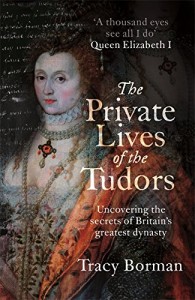Tracy Borman is the author of ‘Thomas Cromwell: The Hidden Story of Henry VIII’s Most Faithful Servant’, ‘The Story of the Tower of London’, ‘Witches: A Tale of Sorcery, Scandal and Seduction’, ‘Matilda: Queen of the Conqueror’, ‘Elizabeth’s Women: The Hidden Story of the Virgin Queen’ and ‘Henrietta Howard: King’s Mistress, Queen’s Servant.’
Her new book, ‘The Private Lives of the Tudors: Uncovering the Secrets of Britain’s Greatest Dynasty’ was published in the UK in May and will be published in the US on 19th July.
To buy in the UK:
To buy in the USA:
Follow Tracy Borman on Social Media:
Twitter: @TracyBorman
Website: Tracy Borman
Many thanks to Tracy for answering my questions.
Why did you choose this subject for your book?
The inspiration for this book came from my job as joint Chief Curator at Historic Royal Palaces. I am lucky enough to be based at Hampton Court Palace. Although visitors marvel at the splendour of this magnificent palace, what they really want to know about Henry VIII and his fellow Tudor monarchs is rather more basic than their taste in art and architecture. Where did they go to the toilet? How did they wash their clothes? Where did they sleep? I realised that I wanted to know more about these things myself.
What does your book add to existing works about the Tudors?
I have studied the Tudors for many years and thought that I knew them inside out. But exploring these iconic monarchs through the lens of those who attended them in private reveals an entirely different side to their characters, tastes and appearance. And it was not always a pretty sight.
What surprised you most researching this book? I was intrigued to learn that Henry VIII kept the Garter robes belonging to his dead brother, Arthur.
At least three of the Tudor monarchs changed significantly for me during the course of my research, and none more so than Henry VIII. His public image was formidable and intimidating, but in private he was described as ‘the most timid man you could hope to meet’. Perhaps due to the tragic fate of his elder brother Arthur, Henry was a hypochondriac and was plagued by fear of sickness throughout his life. He submitted himself daily to the examinations of his physicians and also kept a secret medicine cabinet in his privy chamber that included remedies of his own devising. Researching Henry’s life behind closed doors also revealed that the king suffered from a range of embarrassing health complaints throughout his life. I ended up feeling sorry for the man who I had always seen as something of a tyrant.
What sources did you find most useful during your research?
The sources were so rich and varied that it is hard to select just a few. But among the most revealing were the eyewitness accounts by the men and women who served the Tudors in their privy chamber. From the ladies and gentlemen of the bedchamber to the most intimate body servant of all: the groom of the stool. The household accounts also offer up fascinating details about how the Tudors liked to spend their leisure hours. Who would have thought that ‘Bloody’ Mary was addicted to gambling and wine?
What was your favourite secret that you uncovered?
There are so many! But it has to be the fact that Henry VII, who for centuries has been seen as a miser, was in fact a shopaholic. It was fascinating to study his wardrobe accounts and find out just how much he spent on clothes – the equivalent of £3 million in the first two years of his reign alone. Tracing the pattern of his wardrobe expenditure, it became clear that it peaked at times of crisis in his reign, such as during the mid 1490s when the ‘pretender’ Perkin Warbeck was threatening to invade. It betrays a deep-seated insecurity on the part of the first Tudor king that he felt the need to enhance his appearance when he was under threat. It’s a very natural reaction, and one that we can still relate to today. I know I always feel the need to buy a new outfit for an event that I’m nervous about!
Who was the most difficult monarch to write about?
Edward VI was perhaps the greatest challenge because, thanks to the fact that he died so young, a large part of his private life was missing – namely his love life. It is also hard to penetrate his exterior image and find out his private hopes and desires. Even though he was the only Tudor monarch to keep a diary, it is a very staid account of events and the young king appears rather cold and unfeeling. For example, the execution of his once-beloved uncle, Edward Seymour, is afforded only the following cursory mention: ‘The Duke of Somerset had his head cut off this morning.’
You write about Jane Grey that, ‘on the day that she was proclaimed queen, she was obliged to wear a pair of Italian-style ‘chopines’, or heeled shoes, to give her greater height – and therefore enhance her regal status’ (p243-4). The description of Jane wearing wooden platform shoes comes from the letter written by Baptista Spinola on 10th July 1553. In ‘The Sisters Who Would Be Queen (paperback) and ‘Tudor: The Family Story’, Leanda de Lisle argues that the letter is a fake. Do you have an opinion about this?
I have found no evidence to suggest that the letter is a fake. I sought the advice of an expert on the subject: Eleri Lynn, dress curator at Historic Royal Palaces. I was also privileged to have a preview of the stunning new biography of Jane by Nicola Tallis. Her research is extensive and impeccable, and she conveys it in an incredibly engaging way. Fans of Jane are in for a treat!
How important were their private lives to the Tudor monarchs?
They were absolutely essential, both for their wellbeing and their power. The Tudors were highly skilled at creating a very distinct division between their public and private lives. This helped to preserve and enhance the image of majesty. When the Tudor dynasty died out with Elizabeth I in 1603 and the Stuarts came to power, they did things very differently. James I did not appreciate the need to keep his public and private lives separate, and had little patience for the elaborate ceremonial that the Tudors had created around both. As a result, he lived his increasingly sordid ‘private’ life on a public stage – and rapidly lost the love and respect of his people. Even by the end of his reign, the Stuart dynasty was already looking dangerously unstable. It now became obvious that it had been the private lives of the Tudors, just as much as their public displays of magnificence, that had been the secret of their success.
My ‘Elizabeth’s Women’ interview with Tracy.



































